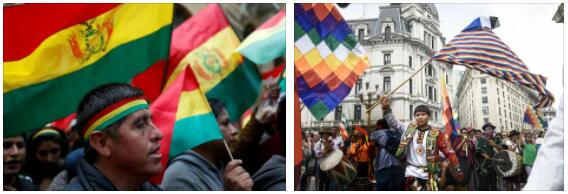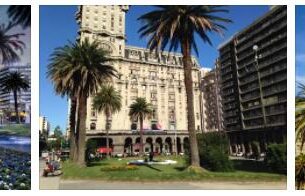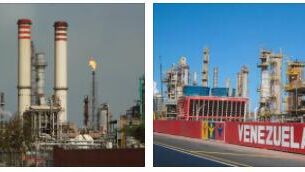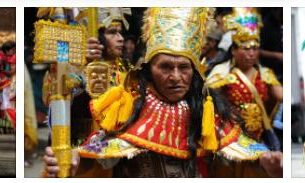After the return to constitutional forms of government in Bolivia, approx. 70 political parties. As democracy consolidated and the economy stabilized, the extreme fragmentation and polarization of political parties began to decrease. Three main political forces came to the fore – the Nationalist Revolutionary Movement (MNR), the Left Revolutionary Movement (MIR) and the Nationalist Democratic Action (ADN). After 1985, the ideological differences between the leading parties began to gradually blur, often they form a ruling coalition and proclaim similar economic policies aimed at implementing the neoliberal model with a greater or lesser degree of social protection. The above parties fail to fill the entire political space: Populist movements such as the Conscience of the Motherland (CONDEPA) and the Civil Union Solidarity (UCS) also enjoy significant voter support. In recent years, notable success has been achieved by other populist parties that have recently emerged – the center-right New Republican Force (NFR) (leader – retired military M. Reyes Villa) and the Movement to Socialism (MAS), uniting Indian peasants who advocate the legalization of coca production (leader – H.E. Mora-les Aima). All parties are characterized by excessive personalization, weak ties with mass organizations and movements. uniting Indian peasants who advocate the legalization of coca production (leader – H.E. Mora-les Aima). All parties are characterized by excessive personalization, weak ties with mass organizations and movements. uniting Indian peasants who advocate the legalization of coca production (leader – H.E. Mora-les Aima). All parties are characterized by excessive personalization, weak ties with mass organizations and movements. Check diseaseslearning for political system of Bolivia.
According to the results of the parliamentary elections on June 30, 2002, the seats in the National Congress were distributed as follows: the Nationalist Revolutionary Movement – 36 seats in the Chamber of Deputies and 11 in the Senate, the Movement to Socialism – 27 and 8, respectively, the Left Revolutionary Movement – 26 and 5, the New Republican Force – 25 and 5, Nationalist Democratic Action – 4 and 1. The Pachacuti Indian Movement, the Civil Union “Solidarity” and the Socialist Party took 6, 5 and 1 seats respectively in the Chamber of Deputies (not represented in the Senate).
In the presidential elections (June 2002), among 11 candidates, relative success was achieved by G. Sanchez de Lozada Bustamante (MNR) (22.46% of the vote), J.E. Morales (MAS) (20.94%), M. Reyes Villa (NFR) (20.91%) and J. Paz Zamora (MIR) (16.31%). When voting in Congress, Sanchez de Lozada received 84 votes and became president (he resigned in October 2003). The ruling coalition included MNR, MIR, ADN and UCS.
The Confederation of Private Employers of Bolivia, the Bolivian Workers’ Center (trade unions), as well as some peasant organizations and civil committees continue to be important political actors.
Successive governments since 1985 have pursued a similar foreign and domestic policy based on the neoliberal model and monetarist methods in accordance with the recommendations of the IMF. The focus is on privatization economy, the liberalization of foreign trade, the suppression of inflation, the introduction of a floating exchange rate of the national currency against the US dollar. During the past decade, state-owned airlines, the telephone company, railroads, electric grids, and oil companies have been privatized. The process of privatization and rationalization of production causes dissatisfaction with a certain part of the population, which requires an adjustment of the neoliberal course. (Riots took place in April, September and October 2000, September and October 2003). All governments declare their intention to strengthen the democratic process, maintain economic stability, pay more attention to improving the living standards of the population and reducing unemployment, but low economic growth rates make it impossible to implement the declared policy in practice. The main problems of the current government are poverty, social instability, drug production and corruption. The declared priorities are attraction of foreign investments, development and improvement of the education system, continuation of privatization, fight against corruption.
Bolivia actively advocates for the strengthening of peace and international security and participates in the work of regional and international organizations. The main foreign policy and economic partner of Bolivia, the source of financial, economic and military assistance is the United States. Close cooperation between government circles and the United States is aimed at eliminating drug-containing crops, primarily coca, but such a policy is protested by a significant part of the population. Bolivia coordinates its foreign policy with the countries of the Andean region, signed a free trade agreement with Mexico and became an associate member of MER-COSUR. An important place is also occupied by the country’s desire to achieve access to the sea.
Bolivia’s armed forces include the army, navy, air force and national police. The country has compulsory military service. In 2002, the number of men who have reached military age (19 years) amounted to 90.1 thousand people. In 1999, military spending amounted to 147 million US dollars (1.8% of GDP).
Bolivia has diplomatic relations with the Russian Federation (established with the USSR in April 1945, the exchange of representations took place in 1969).



